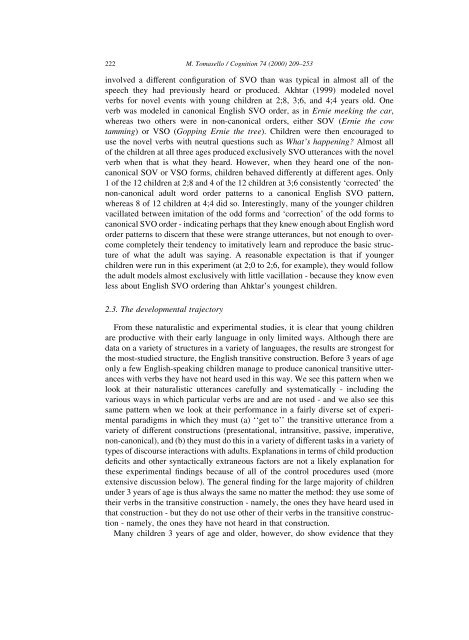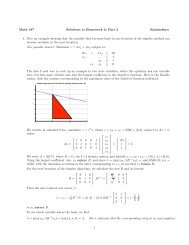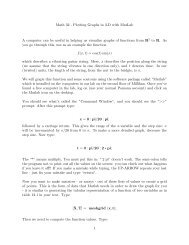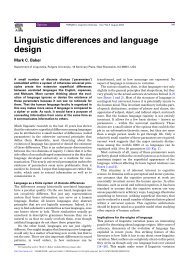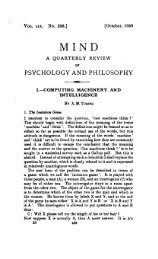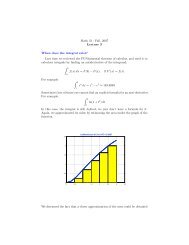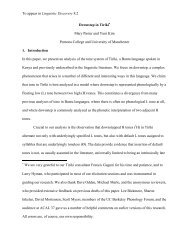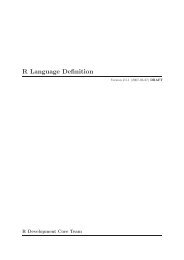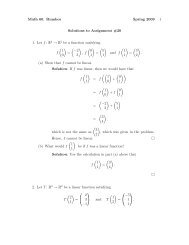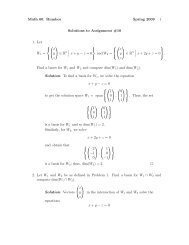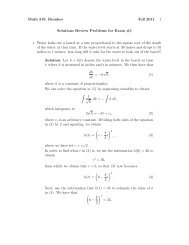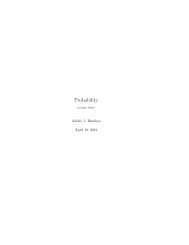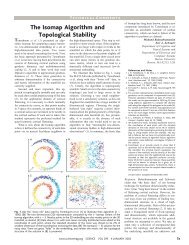Tomasello
Tomasello
Tomasello
You also want an ePaper? Increase the reach of your titles
YUMPU automatically turns print PDFs into web optimized ePapers that Google loves.
222M. <strong>Tomasello</strong> / Cognition 74 (2000) 209±253involved a different con®guration of SVO than was typical in almost all of thespeech they had previously heard or produced. Akhtar (1999) modeled novelverbs for novel events with young children at 2;8, 3;6, and 4;4 years old. Oneverb was modeled in canonical English SVO order, as in Ernie meeking the car,whereas two others were in non-canonical orders, either SOV (Ernie the cowtamming) or VSO (Gopping Ernie the tree). Children were then encouraged touse the novel verbs with neutral questions such as What's happening? Almost allof the children at all three ages produced exclusively SVO utterances with the novelverb when that is what they heard. However, when they heard one of the noncanonicalSOV or VSO forms, children behaved differently at different ages. Only1 of the 12 children at 2;8 and 4 of the 12 children at 3;6 consistently `corrected' thenon-canonical adult word order patterns to a canonical English SVO pattern,whereas 8 of 12 children at 4;4 did so. Interestingly, many of the younger childrenvacillated between imitation of the odd forms and `correction' of the odd forms tocanonical SVO order - indicating perhaps that they knew enough about English wordorder patterns to discern that these were strange utterances, but not enough to overcomecompletely their tendency to imitatively learn and reproduce the basic structureof what the adult was saying. A reasonable expectation is that if youngerchildren were run in this experiment (at 2;0 to 2;6, for example), they would followthe adult models almost exclusively with little vacillation - because they know evenless about English SVO ordering than Ahktar's youngest children.2.3. The developmental trajectoryFrom these naturalistic and experimental studies, it is clear that young childrenare productive with their early language in only limited ways. Although there aredata on a variety of structures in a variety of languages, the results are strongest forthe most-studied structure, the English transitive construction. Before 3 years of ageonly a few English-speaking children manage to produce canonical transitive utteranceswith verbs they have not heard used in this way. We see this pattern when welook at their naturalistic utterances carefully and systematically - including thevarious ways in which particular verbs are and are not used - and we also see thissame pattern when we look at their performance in a fairly diverse set of experimentalparadigms in which they must (a) ``get to'' the transitive utterance from avariety of different constructions (presentational, intransitive, passive, imperative,non-canonical), and (b) they must do this in a variety of different tasks in a variety oftypes of discourse interactions with adults. Explanations in terms of child productionde®cits and other syntactically extraneous factors are not a likely explanation forthese experimental ®ndings because of all of the control procedures used (moreextensive discussion below). The general ®nding for the large majority of childrenunder 3 years of age is thus always the same no matter the method: they use some oftheir verbs in the transitive construction - namely, the ones they have heard used inthat construction - but they do not use other of their verbs in the transitive construction- namely, the ones they have not heard in that construction.Many children 3 years of age and older, however, do show evidence that they


